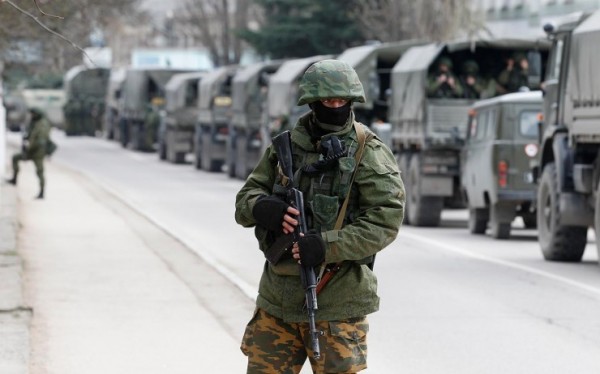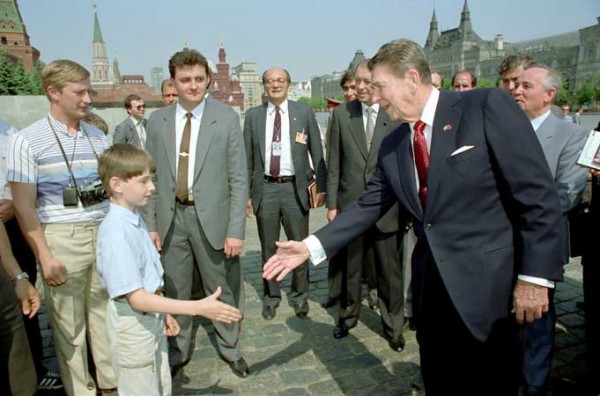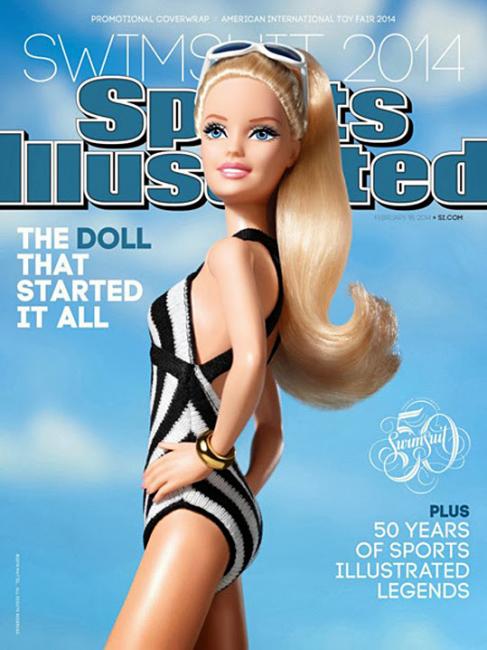Notes
On the Russian Military Using Unmarked Uniforms
Of all the photographs to come out of the crisis in the Ukraine, this one may be the most troubling.
It’s not dramatic; indeed, nothing is moving. It’s not chaotic; instead, we see an orderly deployment of disciplined troops. It’s threatening, but in a somewhat abstract, obviously calculated way; the guards are attentive, but the guns are pointed down. You are witnessing an invasion, but it looks more like a training exercise or a bluff that is part of a larger diplomatic maneuver. The troop carriers are chess pieces in another Great Game, perhaps, but not likely to unleash destruction on the city where they are parked so neatly. That’s one of the purposes to which modern armies are put; because all sides can count on the professionalism and discipline of a modern army, while remaining well aware of its incredible lethality, the soldiers can be moved up to one line or the next without having to worry about things getting out of control–on the ground, anyway.
So what’s the problem? The problem is that the soldiers are Russian troops. This is not a post about the legitimacy of the invasion, so I’m not slamming them for being Russian. The problem is that they are Russian, that is, very, very, very likely to be Russian military forces who nonetheless are wearing uniforms having no insignia.
You can be excused for not thinking that is much of a problem, because–and this is equally astonishing to me–everyone has been talking about them as if their anonymity were the most normal thing in the world, or just a small wrinkle in what is otherwise a completely legible situation. Or, if the situation is not legible, it’s because of the bigger problems of deciphering the work of a madman (Putin, as labeled by The New Republic and the Huffington Post: “Vlad Goes Mad”), or the Russian susceptibility to “mysticism” and “messianic ideology” (David Brooks in the New York Times). (Politics should be so simple.) But as for the troops themselves, we all know they are Russian, so what’s the big deal about not wearing insignia? Isn’t the military preoccupation with badges a bit silly anyway? Or couldn’t it be a rather clever tactic, diplomatically speaking?
Call me old school, but I think it’s important for the professional military of a modern state to be identifiable as such. This isn’t a question of merely literal recognition–was that the 184th or the 185th brigade?–but of the legitimacy of the state’s monopoly on force. If soldiers are not wearing insignia, they are partially out of uniform; if they are partially out of uniform, they are that much closer to being private militias, gangs, or thugs. The informality can be justified if they are noble partisans battling against conquest or tyranny, because resources are limited, invisibility is necessary, and they disband after victory. But it is definitely an odd thing when the unmarked troops are state troops and the occupying army. Something important has shifted: you still have all the lethality of state power, but the social contract that went along with that concentration of force has been weakened. The army is still there, but less accountable. Still under professional command, but not under legal authority.
So take another look. Consider how the face cowling might be about more than keeping out the cold. Notice, as you look across similar pictures, how systematic the erasure has been; again, you see all the marks of military organization, except one. Imagine what it’s like when such dark forces roll into town; not knowing if they are terrorists, bandits, renegades, militias, gangs, vigilantes, or some other example of what happens when war unleashes lawless predation. Consider, most of all, how the appearance of the anonymous troops in the Crimea suggests how the distinction between those groups and the Russian military is becoming tenuous. Not in organization or discipline, but in something equally important: in the relationship between the army and society.
Nor is this just about the Russians, because the lack of reaction in “the West” suggests that the shift may be occurring much more widely. Think of all those out of uniform “contractors”–i.e., mercenaries–hired by the US government for work in Iraq, including guard detail for State Department officials. If the state’s monopoly on violence begins to adopt the appearance and techniques of stateless violence, then the state is eroding as a political form. Of course, state sanctioned violence has been anything but a lesson in restraint, but it has been relatively beneficial in comparison with many of the warlord eras in history or any of the natural experiments in anarchy now underway in Africa and the Middle East. The choice, however, apparently is no longer between modern and premodern violence. It looks to me like a third kind of force may be emerging, something for which we don’t yet have a vocabulary.
Fortunately, we do have a photograph. It’s not everything, but it’s start.
— Robert Hariman
(cross-posted from No Caption Needed.)
(photo: Baz Ratner/Reuters. caption: Armed servicemen wait in Russian army vehicles in the Crimean town of Balaclava, March 1, 2014.)



Reactions
Comments Powered by Disqus